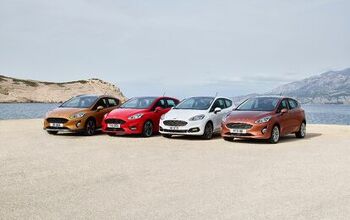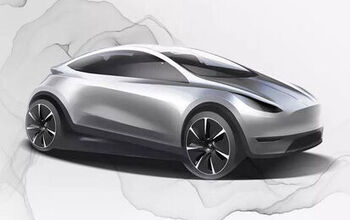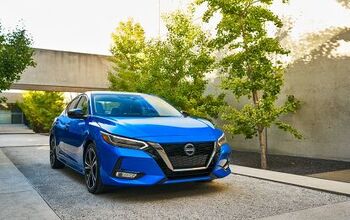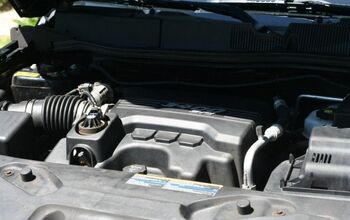Thinking Small
If the first step on the road to recovery is admitting you have a problem, congratulations Ford, you’re on your way. The Blue Oval Crew recently admitted that their overly-long product cycles were partly to blame for their current financial queasiness. As the surprisingly satisfied owner of a 2000 Focus, I’ve earned the right to say: ‘bout time. I was worried that the marketers’ standard question “Would you buy this car again?” had become strictly hypothetical.
In the six years since my Focus was new, I’ve changed jobs twice and addresses three times. I got married, we’ve had a couple kids and what’s left of my hair is going a little gray. I’m not exactly the same person I was in 2000. But the Focus is basically the same car, save for a different engine and a couple minor styling fluff ‘n buffs. The rest of the world got a groovy new Focus two years ago. We got a chrome grille surround.
Why would any auto manufacturer have its products on a life cycle greatly exceeding the average term of a car loan? I mean, I get the whole Alfred Sloan/GM ascending the social ladder business model. There’s a car for everybody, but never the same car twice (unless it’s expensive). Since I liked the Focus so well, I should be ready to trade up to the Fusion or Milan, right? Wouldn’t I really rather have a little bit bigger, classier car this time around? After all, I’m older and I’ve moved up in the world, haven’t I? Or maybe a family guy like me needs something with some cargo capacity. You can get two Pack & Plays into the back of an Escape, after all. Hey, we could get you into a lease on a new Explorer for a few dollars more . . .
The problem is, I actually like small cars. I don’t want or need anything bigger. Most of the time, it’s just me, my briefcase and a cup of coffee. And I kinda like 30mpg. I really want another small car— but one that offers me up-to-date engineering and design. If Ford can’t provide it, what about some other “American” brand? Chevy will sell me an Aveo (they didn’t build) or a Cobalt (I still can’t tell from the Cavalier it replaced). Saturn has an Ion, which is basically the same car as the Cobalt except it goes “boing” instead of “crunch” in a fender-bender. And DaimlerChrysler won’t sell me a car at all. I have my choice of a snack-sized SUV called the Dodge Caliber or a PT Cruiser only slightly less superannuated than my Focus. I could wait for the possible Dodge Hornet, but if I wanted to wait, would I be complaining about the all-new Focus I can’t have yet?
You’d think the Big Three would have learned the lesson of the ‘73 and ‘79 energy crises. You’d think they’d stay competitive in the small car market. You never know when an outbreak of hurricanes or mullahs will blow up gas prices, making car buyers think small again. But since the modern era of American subcompacts kicked off with the 1970 AMC Gremlin, how many American small cars have been world-class?
Maybe two: the 1995 Neon and the 2000 Focus. Otherwise, American consumers have been treated to a desultory deluge of dorkmobiles. You know the names. Go look up the numbers. A solid decade of Pintos. Twelve years of Chevettes, Omnis, and Horizons. Thirteen years of the first-generation Cavalier, followed by eleven years of the second generation. All of this while the imported competition was on four- to five-year design cycles. Small cars are still showroom pogey bait, as far as Detroit is concerned. It’s just that these days they’ll push an SUV or a crossover on you, not an LTD.
You’re not supposed to fall in love with small cars. You’re supposed to fall in love with their prices, notice their shortcomings immediately, then decide that maybe you can swing the payments on a new Malibu after all. So I guess I’m barking up the wrong org charts. I didn’t realize that small cars are supposed to be a pit stop, not a destination. I’m a bad customer for preferring a small car after I can finally afford a big one.
All it would take to keep my dollars flowing Detroitwards is for some manufacturer to show me that they care enough about small-car buyers to offer us two world-class efforts in a row, without a couple Olympiads in between. Will Ford’s new short design cycles lead us to better cars more often or will they lead to half-finished beta tests? Time will tell. But it’s OK– for some. The steadfast (if endangered) American car buyer is used to waiting.
More by Mark Hasty
Latest Car Reviews
Read moreLatest Product Reviews
Read moreRecent Comments
- MaintenanceCosts Nobody here seems to acknowledge that there are multiple use cases for cars.Some people spend all their time driving all over the country and need every mile and minute of time savings. ICE cars are better for them right now.Some people only drive locally and fly when they travel. For them, there's probably a range number that works, and they don't really need more. For the uses for which we use our EV, that would be around 150 miles. The other thing about a low range requirement is it can make 120V charging viable. If you don't drive more than an average of about 40 miles/day, you can probably get enough electrons through a wall outlet. We spent over two years charging our Bolt only through 120V, while our house was getting rebuilt, and never had an issue.Those are extremes. There are all sorts of use cases in between, which probably represent the majority of drivers. For some users, what's needed is more range. But I think for most users, what's needed is better charging. Retrofit apartment garages like Tim's with 240V outlets at every spot. Install more L3 chargers in supermarket parking lots and alongside gas stations. Make chargers that work like Tesla Superchargers as ubiquitous as gas stations, and EV charging will not be an issue for most users.
- MaintenanceCosts I don't have an opinion on whether any one plant unionizing is the right answer, but the employees sure need to have the right to organize. Unions or the credible threat of unionization are the only thing, history has proven, that can keep employers honest. Without it, we've seen over and over, the employers have complete power over the workers and feel free to exploit the workers however they see fit. (And don't tell me "oh, the workers can just leave" - in an oligopolistic industry, working conditions quickly converge, and there's not another employer right around the corner.)
- Kjhkjlhkjhkljh kljhjkhjklhkjh [h3]Wake me up when it is a 1989 635Csi with a M88/3[/h3]
- BrandX "I can charge using the 240V outlets, sure, but it’s slow."No it's not. That's what all home chargers use - 240V.
- Jalop1991 does the odometer represent itself in an analog fashion? Will the numbers roll slowly and stop wherever, or do they just blink to the next number like any old boring modern car?































Comments
Join the conversation
Europeans are willing to pay more money for a small car then their american cousins. Almost the whole market is below the Toyota Camry or Mercedes E-Class in size. The reasons are various. Tradition, taxes, economy, parking spaces, parking availabilty, narrow streets in medieval towns, personal needs, and so on. Just because you have the money you don't need to buy big or expensive. But that also means that people have more money available to use for a smaller car. That's why the premiumification of small cars are being made in Europe. The Mini is fashionista-chic. As is the Mercedes A-Class and Smart. That's why the VW Golf and Audi A3 sells in numbers far higher than their bread-and-butter counterparts Focus and Astra. The 1997 Golf IV really made an impact in the pursuit for high quality in that market sector. The first generation Focus was a really good car, almost over-engineered in Fords attempt to up the antes. That made Fords earnings smaller per sold car, and can perhaps be accounted for Fords bean-counted second-gen european version, and Fords decision not to sell the second-gen in USA. Americans are per tradition not willing to pay large money for a small car. Instead of investing money in technique, safety and engineering, they prefer to buy a larger car. Instead of paying more for a refined second generation Focus, they prefer to pay the same money and buy an entry level Ford Fusion.